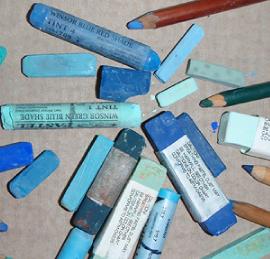 |
||||||||
 |
||||||||
About Pastels Pastel (sometimes referred to as soft pastel to distinguish it from oil pastel, which is a different medium) is a dry medium in a stick form, consisting of powdered pigments held together with a minimal amount of a binder (usually gum tragacanth). Pigments used in making pastels are the same pigments that are ground for use in making oil and watercolor paints. Painting with pastels, therefore, is as close as one can get to painting with pure pigment. Pastels are the most permanent artists' medium, if properly created and protected. Pastels should be done on an archival surface which is free of acid, and should be framed under glass, preferably with a spacer between the glass and the surface of the painting. As the pigments are the same as those used in oil paintings, you should expect the same level of resistance to fading. Traditionally used in the 18th century for painting royal portraiture, the soft pastel medium can trace its roots back to prehistoric cave paintings. In and out of style in the last four centuries, pastels are now enjoying a modern-day resurgence of popularity, due to their intense colors, permanence and "immediate" handling, and the relatively new existence of archival supports on which to work. |
||||
 |
||||
My pastel work is created and framed for maximum protection and permanence. It is created on an acid-free and/or archival surface. The pastels used are the finest in light-fastness currently available on the market (equivalent to oils in light-fastness). It is currently framed with an acid free backing and spacers to separate the surface of the painting from the glass. It is framed with museum glass. My pastel work is made using only environmentally non-toxic materials, given the fragile environment in which I work. Pastel in general, however, is considered a non-toxic medium. |
||
Caring for your pastel You only need to know a few things about caring for your pastel. |
||
When transporting, lay a pastel glass side up, never glass side down |
||||
When not hanging, store a pastel glass side up or upright, never glass side down. |
||||
When shipping, leave the job to professionals, who know how to pack and ship pastels specifically. If uncertain of who to contact in your area for shipping, contact a local pastel association. Its members likely can supply you with a reputable, knowledgeable shipper in your area. If you choose to ship yourself, an AirFloat system, or similar product, is recommended. |
||||
If reframing, be sure to leave a spacer between the pastel's surface and the glass or mat. If a mat is used, use an acid-free mat. Plexiglass instead of glass is an option to lower weight and make shipping easier, but the static generated by plexiglass can be a problem. |
||||